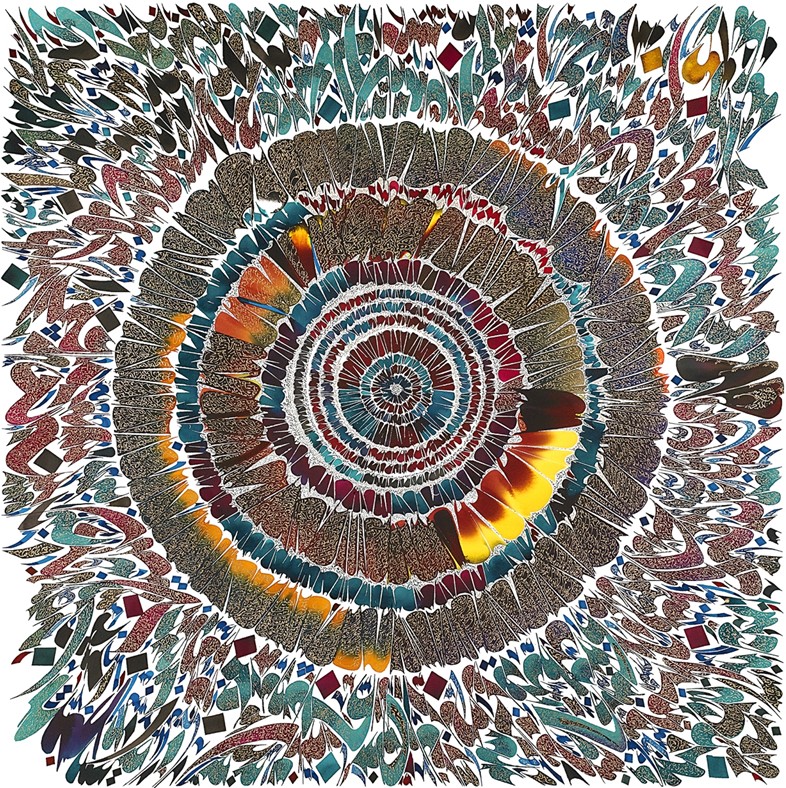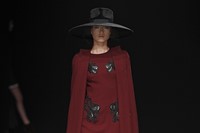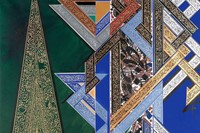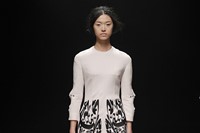We celebrate a collision of fashion and art in the A/W13 collection of Marios Schwab, decorated in embroidery by Nja Mahdaoui
For his highly praised A/W13 collection, Marios Schwab decided to fully embrace his Mediterranean heritage (the London-based designer is half Greek, half Austrian) by collaborating with Tunisian artist Nja Mahdaoui. 76-year-old Mahdaoui created intricate Arab-inspired calligrams (imaginary letters) embroidered by Schwab over dresses, tops and skirts, framing the female body in a sensuous, enigmatic way. Intrigued by the collaboration, AnOther caught up with both the designer and the artist to discuss inspiration, synergy and the creative process.
What was the starting point of your autumn/winter collection?
Marios Schwab: It all began with me being inspired by the romanticism of the written language, which is a rare factor in our society. That led me to calligraphy, which has this sort of tactile beauty about it. The action of writing – putting letters on a blank page – can be so very personal.
How did you come to know each other’s work?
MS: A friend from Paris introduced me to Nja’s work a few years ago, and from that point I followed him closely. I have always loved Arabic script, it is a form of artistry which is very nostalgic and is associated with stories and poems. Because the collection was very much about the disappearance of the written language, I thought it would be beautiful to link it to Nja’s work…
Nja Mahdaoui: I didn’t know Marios’s work until he contacted me suggesting a collaboration. I don’t generally work with fashion designers but I was very impressed by his sensibility and his maturity at such a young age! I was immediately curious to see where a team effort would lead us.
Not speaking the same language, did you find communication difficult?
NM: Marios has a fantastic assistant who speaks French and did all the necessary translation. Thanks to her, and to the fact that I felt a deep connection with Marios’s creative universe, our conversation was surprisingly fluent.
MS: Nja understood the DNA of the label and our fashion perspective from the start. He has an immense knowledge of history, of art – even of embroidery and embellishment. His culture made communication possible, even if he didn’t speak English and I didn’t speak French.
"Thanks to the fact that I felt a deep connection with Marios’s creative universe, our conversation was surprisingly fluent" — Nja Mahdaoui
How did the creative process take place?
NM: In a very organic way. Marios would send me his sketches and I would create the calligrams for each one of the looks, which he’d later transform into embroideries.
MS: Even if he works with a lot of freedom, Nja’s art can be quite mathematical and geometrical. My work is pretty much at the opposite of that, so it was incredibly interesting and enriching to merge our different approaches to creating.
What do calligrams have in common with the female body?
MS: Nja concentrates on calligraphy without necessarily associating it with a meaning, rather exploring its lines, shapes and movement. My work, on the other hand, is about anatomy and proportion, so I think both disciplines complement each other beautifully on a woman’s body.
The collection was also inspired by 15th century Dutch painter Petrus Christus. Was combining such different references a new challenge for you?
MS: I thought it would be, but it wasn’t! Petrus Christus’s work, not unlike Nja’s, has a timeless quality and was ahead of its time. The sharp graphic details of his paintings, the gaze and the rich colour inspired the cut of the collection, framing the bust and paying homage to femininity.
How important is your heritage – and tradition – in your work?
NM: Local traditions can be a good thing, and of course we are all to a certain extent defined by our heritage. However, I have an ambivalent relationship with tradition; I see it also as potentially leading to intolerance and bigotry. My work unconsciously stems from my heritage, but consciously I always try to steer away from tradition. I’d rather search for new horizons instead.
Text by Marta Represa



